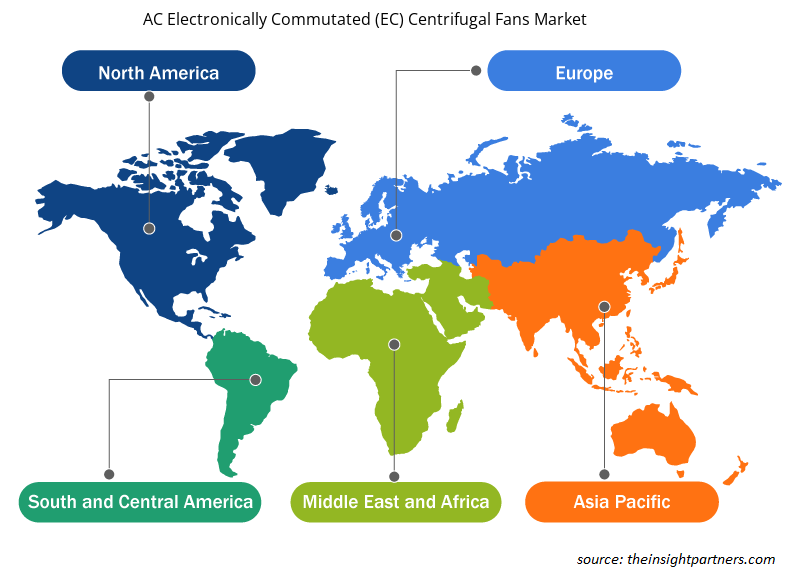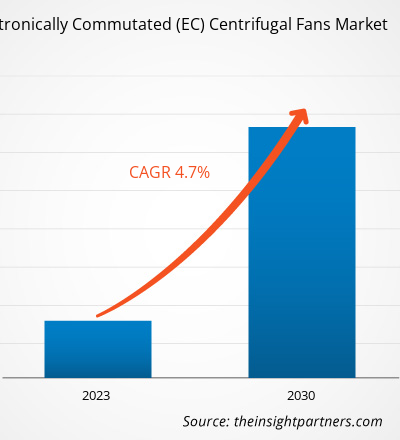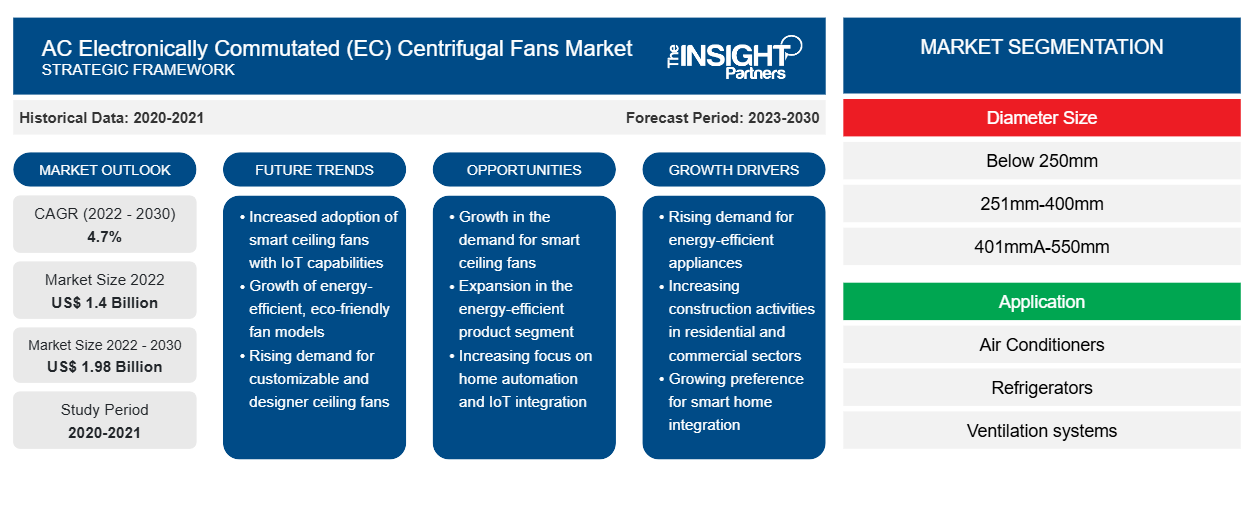[Rapporto di ricerca] Si prevede che il mercato dei ventilatori centrifughi a commutazione elettronica (EC) AC crescerà da 1.403,06 milioni di dollari nel 2022 a 1.979,65 milioni di dollari entro il 2030; si stima che registrerà un CAGR del 4,7% dal 2023 al 2030.
Prospettiva dell'analista di mercato dei ventilatori centrifughi a commutazione elettronica (EC) AC:
La tecnologia a commutazione elettronica (EC) combina tensioni CA e CC per ottenere il risultato più desiderato. L'EC funziona con una tensione CC con un'alimentazione CA monofase da 230 V o trifase da 400 V. La parte non rotante dei motori EC è estesa per fare spazio a una scheda a circuito stampato elettronica (PCB), che include la trasformazione di potenza CA in CC e i controlli. L'elettronica EC è diversa dagli inverter di frequenza e decide come le fasi del motore dello statore sono alimentate con corrente (commutazione), a seconda della posizione, della direzione di rotazione e dell'impostazione predefinita. I motori EC (ECM) necessitano di un'alimentazione CC individuale, il che comporta costi e complessità aggiuntivi nelle applicazioni. I ventilatori EC che potevano funzionare direttamente dalla rete CA incorporata con l'elettronica sono diventati disponibili all'inizio degli anni 2000. L'elettronica nei ventilatori EC trasformava la CA in CC, realizzava la commutazione e azionava la velocità del ventilatore controllando la potenza del motore, generalmente con modulazione di larghezza di impulso (PWM).
Panoramica del mercato dei ventilatori centrifughi a commutazione elettronica (EC) AC:
Diversi paesi nel mondo si stanno concentrando sul risparmio energetico attraverso l'implementazione di diverse strategie. Il Dipartimento dell'Energia degli Stati Uniti (DOE) ha verificato che i componenti di apparecchiature ed elettrodomestici e i sistemi azionati da motori elettrici rappresentano circa il 25% del consumo di energia primaria dei settori residenziale e commerciale. La sostituzione delle attuali apparecchiature con motori innovativi a risparmio energetico comporta un notevole calo dei costi e dell'utilizzo di energia. I ventilatori EC consentono notevoli risparmi energetici, offrendo soluzioni di flusso d'aria e raffreddamento per applicazioni con migliori requisiti di efficienza elettrica. Si prevede che questo fattore spingerà il mercato globale dei ventilatori centrifughi a commutazione elettronica (EC) AC durante il periodo di previsione.
Personalizza questo report in base alle tue esigenze
Riceverai la personalizzazione gratuita di qualsiasi report, comprese parti di questo report, o analisi a livello nazionale, pacchetto dati Excel, oltre a usufruire di grandi offerte e sconti per start-up e università
-
Scopri le principali tendenze di mercato in questo rapporto.Questo campione GRATUITO includerà analisi di dati che spaziano dalle tendenze di mercato alle stime e alle previsioni.
Limitazioni di mercato per i ventilatori centrifughi a commutazione elettronica (EC) AC:Commutated (EC) Centrifugal Fans Market Restraint:
Crescente utilizzo di motori sincroni a magneti permanenti intelligenti per limitare la crescita del mercato dei ventilatori centrifughi a commutazione elettronica (EC) ACCommutated (EC) Centrifugal Fans Market
I motori sincroni a magnete permanente intelligenti (SSPMM) consumano meno energia e conferiscono maggiore efficienza. I motori sincroni sono utilizzati negli attuatori dei robot, nei mulini a sfere, negli orologi, nei giradischi e nei piatti. I motori sincroni a magnete permanente intelligenti aiutano a saltare il processo di conversione di potenza dopo l'avvio del motore, il che porta a risparmi energetici e aumenti di efficienza. Gli SSPMM eliminano l'uso di componenti elettronici e utilizzano una bobina per qualsiasi picco di linea. Inoltre, una maggiore efficienza e una minore perdita di potenza degli SSPMM riducono la temperatura di esercizio e aumentano la durata di funzionamento prevista.SSPMMs) consume less energy and confer greater efficiency. SSPMMs eliminate the use of electronics and use a coil for any surge in line. Moreover, greater efficiency and lower power loss of the SSPMM reduce the operating temperature and increase the expected operation life.
Inoltre, il mercato dei motori sincroni intelligenti a magneti permanenti spesso soddisfa segmenti e applicazioni diversi. I motori sincroni intelligenti a magneti permanenti trovano applicazione in vari settori, tra cui automotive, robotica e macchinari industriali, dove sono necessari motori ad alte prestazioni. Inoltre, gli SSPMM eccellono in determinate applicazioni in cui coppia elevata e densità di potenza sono essenziali. Pertanto, l'uso crescente degli SSPMM frena la crescita del mercato dei ventilatori centrifughi a commutazione elettronica (EC) in corrente alternata.SSPMMs excel in certain applications where high torque and power density are essential. Therefore, the surging use of SSPMMs restrains AC Electronically Commutated (EC) Centrifugal Fans market growth.
Analisi segmentale del mercato dei ventilatori centrifughi a commutazione elettronica (EC) AC:Commutated (EC) Centrifugal Fans Market Segmental Analysis:
In base all'applicazione, il mercato dei ventilatori centrifughi a commutazione elettronica (EC) AC è stato segmentato in condizionatori d'aria, frigoriferi, sistemi di ventilazione, armadi elettronici e altri. Si prevede che il segmento dei condizionatori d'aria rappresenterà la quota di mercato più grande dei ventilatori centrifughi a commutazione elettronica (EC) AC nel 2023. L'aria condizionata fornisce una velocità maggiore perché l'aria più fredda è più densa. La tecnologia di condizionamento dell'aria sul mercato è caratterizzata da tre requisiti principali che sono l'efficienza energetica, la controllabilità per un buon abbinamento del carico e l'adattabilità per soddisfare un'ampia gamma di esigenze dei clienti. Il motore EC funziona in modo silenzioso ed efficiente anche in condizioni di carico parziale. Tutti i controlli, la programmazione e il monitoraggio dei ventilatori tipicamente necessari nel settore dell'aria condizionata sono disponibili tramite l'elettronica del motore integrata che può essere azionata tramite software e persino accessibile in modalità wireless.commutated (EC) centrifugal fans market has been segmented into air conditioners, refrigerators, ventilation systems, electronic cabinets, and others. The air conditioners segment is expected to account for the largest AC electronically commutated (EC) centrifugal fans market share in 2023. Air conditioning provides faster speed because colder air is denser. Air-conditioning technology in the market is characterized by three main requirements that are energy efficiency, controllability for good load matching, and the adaptability to meet a wide range of customer needs. The EC motor operates quietly and efficiently even under part-load conditions. All fan control, programming, and monitoring typically needed throughout the air-conditioning industry are available through the integrated motor electronics that and can be operated via software and even accessed wirelessly.
Analisi regionale del mercato dei ventilatori centrifughi a commutazione elettronica (EC) AC:
Il mercato globale dei ventilatori centrifughi a commutazione elettronica (EC) AC è suddiviso in cinque regioni principali: Nord America, Europa, APAC, MEA e SAM. L'Europa ha guidato il mercato nel 2022 e si prevede che dominerà la quota di mercato dei ventilatori centrifughi a commutazione elettronica (EC) AC durante il periodo di previsione. Diversi settori in APAC e Nord America stanno spostando i loro stabilimenti di produzione pesante in Europa per aumentare i loro margini di profitto. La crescita del mercato dei ventilatori centrifughi a commutazione elettronica (EC) AC in APAC è principalmente attribuita alla crescente inclinazione al risparmio energetico in vari paesi della regione. Inoltre, i ventilatori EC sono la scelta preferita per ottenere l'efficienza energetica nei motori. I ventilatori e i motori EC conformi allo standard europeo EN 60335-2-89 sono la scelta preferita di diversi produttori di refrigerazione commerciale per applicazioni che comportano l'uso di refrigeranti infiammabili come R290 (propano). Molte aziende elettroniche in Europa stanno sostituendo i ventilatori esistenti con ventilatori EC per le loro caratteristiche di efficienza, controllabilità e risparmio sui costi. Diverse aziende che forniscono ventilatori a commutazione elettronica (EC) hanno adottato l'acquisizione e la fusione come strategia chiave per aumentare la propria presenza geografica e sviluppare le tecnologie dei propri prodotti. A maggio 2019, IKOR, un produttore di ventilatori e motori con sede in Spagna, si è fuso con Ebm-Papst Group. Ebm-Papst Group, con sede a Mulfingen, in Germania, ha una forza lavoro di 15.000 dipendenti, 48 filiali e uffici commerciali e 27 siti di produzione. L'azienda fornisce motori e ventilatori per elettrodomestici, ventilazione e telecomunicazioni. Questa mossa contribuirà a guidare la strategia di crescita sostenibile di IKOR in tutti i mercati di Ebm-Papst Group.
Analisi dei principali attori del mercato dei ventilatori centrifughi a commutazione elettronica (EC) AC:
L'analisi del mercato dei ventilatori centrifughi a commutazione elettronica (EC) AC comprende attori quali Rosenberg Ventilatoren GmbH; Ebm-papst; Delta Electronics; Ziehl-Abegg; Airtècnics; Hidria.; PBM Motor and Fan (suzhou)Co Ltd., Ltd.; Simx Ltd.; Shipox Inc; Regal Rexnord Corp; e Continental Fan sono i due principali attori grazie al portafoglio prodotti diversificato offerto.
Ventilatori centrifughi commutati elettronicamente AC
Approfondimenti regionali sul mercato dei ventilatori centrifughi a commutazione elettronica (EC) AC
Le tendenze regionali e i fattori che influenzano il mercato dei ventilatori centrifughi a commutazione elettronica (EC) AC durante il periodo di previsione sono stati ampiamente spiegati dagli analisti di Insight Partners. Questa sezione discute anche i segmenti di mercato dei ventilatori centrifughi a commutazione elettronica (EC) AC e la geografia in Nord America, Europa, Asia Pacifico, Medio Oriente e Africa e Sud e Centro America.

- Ottieni i dati specifici regionali per il mercato dei ventilatori centrifughi a commutazione elettronica (EC) AC
Ambito del rapporto di mercato sui ventilatori centrifughi a commutazione elettronica (EC) AC
| Attributo del report | Dettagli |
|---|---|
| Dimensioni del mercato nel 2022 | 1,4 miliardi di dollari USA |
| Dimensioni del mercato entro il 2030 | 1,98 miliardi di dollari USA |
| CAGR globale (2022-2030) | 4,7% |
| Dati storici | 2020-2021 |
| Periodo di previsione | 2023-2030 |
| Segmenti coperti |
Per dimensione del diametro
|
| Regioni e Paesi coperti |
America del Nord
|
| Leader di mercato e profili aziendali chiave |
|
Ventilatori centrifughi a commutazione elettronica (EC) AC Densità dei player del mercato: comprendere il suo impatto sulle dinamiche aziendali
Il mercato dei ventilatori centrifughi a commutazione elettronica (EC) AC sta crescendo rapidamente, spinto dalla crescente domanda degli utenti finali dovuta a fattori quali l'evoluzione delle preferenze dei consumatori, i progressi tecnologici e una maggiore consapevolezza dei vantaggi del prodotto. Con l'aumento della domanda, le aziende stanno ampliando la propria offerta, innovando per soddisfare le esigenze dei consumatori e capitalizzando sulle tendenze emergenti, il che alimenta ulteriormente la crescita del mercato.
La densità degli operatori di mercato si riferisce alla distribuzione di aziende o società che operano in un particolare mercato o settore. Indica quanti concorrenti (operatori di mercato) sono presenti in un dato spazio di mercato in relazione alle sue dimensioni o al valore di mercato totale.
Le principali aziende che operano nel mercato dei ventilatori centrifughi a commutazione elettronica (EC) AC sono:
- Delta Elettronica Inc.
- Ziehl-Abegg UK Ltd
- Idrija
- ebm-papst
- Ventilatore continentale
Disclaimer : le aziende elencate sopra non sono classificate secondo un ordine particolare.

- Ottieni una panoramica dei principali attori del mercato dei ventilatori centrifughi a commutazione elettronica (EC) AC
Sviluppi recenti del mercato dei ventilatori centrifughi a commutazione elettronica (EC) AC:
Le strategie inorganiche e organiche, come fusioni e acquisizioni, sono ampiamente adottate dalle aziende nel mercato dei ventilatori centrifughi a commutazione elettronica (EC) ac. Di seguito sono elencati alcuni recenti sviluppi chiave del mercato:
- Nel 2020, Regal Rexonard Corporation ha annunciato il lancio di Regal Perceptiv intelligence. Regal Perceptiv intelligence è un nuovo modo di usare e interagire con i prodotti e i servizi Regal. È hardware, software e "humanware". Perceptiv intelligence è una matrice interconnessa di soluzioni digitali intelligenti che hanno il potenziale di potenziare i clienti quando interagiscono con Regal per massimizzare l'affidabilità delle apparecchiature e la produzione degli impianti.
- Nel 2019, Rosenberg Ventilatoren GmbH ha lanciato un nuovo motore EC di terza generazione, il 30% più potente della seconda generazione. L'integrazione del nuovo motore EC inizia con ruote a ruota libera, ventilatori assiali, ventilatori centrifughi e ECFanGrid. È probabile che sostituisca il motore di seconda generazione in ventilatori standard come ventilatori da tetto, ventilatori a cassone e ventilatori da condotto.
- Analisi storica (2 anni), anno base, previsione (7 anni) con CAGR
- Analisi PEST e SWOT
- Valore/volume delle dimensioni del mercato - Globale, Regionale, Nazionale
- Industria e panorama competitivo
- Set di dati Excel
Report recenti
Testimonianze
Motivo dell'acquisto
- Processo decisionale informato
- Comprensione delle dinamiche di mercato
- Analisi competitiva
- Analisi dei clienti
- Previsioni di mercato
- Mitigazione del rischio
- Pianificazione strategica
- Giustificazione degli investimenti
- Identificazione dei mercati emergenti
- Miglioramento delle strategie di marketing
- Aumento dell'efficienza operativa
- Allineamento alle tendenze normative























 Ottieni un campione gratuito per - Mercato dei ventilatori centrifughi a commutazione elettronica (EC) AC
Ottieni un campione gratuito per - Mercato dei ventilatori centrifughi a commutazione elettronica (EC) AC